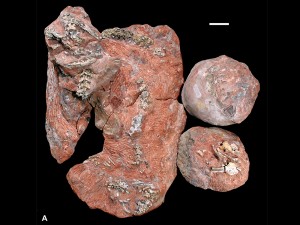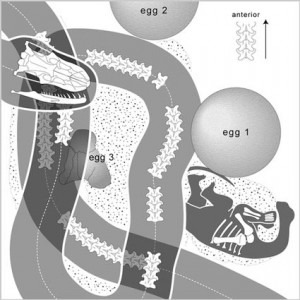Baby Dinosaurs Attacked by Snake
Ancient Indian Constrictor Attacked Baby Sauropods
Scientists have discovered the remarkable fossil of a baby dinosaur that was attacked by a snake.
An adult sauropod would have had few enemies, their sheer size and strength making them invulnerable to attack from all but the most determined or foolhardy theropod. However, the discovery of a fossil from Gujarat in Western India indicates that for baby long-necked dinosaurs, life was very hazardous, even at the moment of hatching from their eggs.
In a paper published in the scientific journal “PLoS Biology”, a team of scientists report on the macabre discovery of a 3.5 metre long snake caught in the act of raiding a sauropod dinosaur’s nest and attacking a newly hatched dinosaur. A number of sauropod nesting sites have been discovered in Western India, in Late Cretaceous deposits (Maastrichtian faunal stage). The nest was that of a titanosaur, the last group of sauropods to evolve. Palaeontologists are confident that these large herbivores migrated to traditional nesting sites year after year and laid their eggs in extensive nesting colonies.
The females would scrape out a hollow in the ground and then carefully lay a clutch of eggs (as many as twelve per nest), then they carefully covered the eggs again, perhaps putting a layer of vegetation on top of the eggs to help incubate them. Then the nest was abandoned and the eggs and any hatchlings left to their fate. Such nesting sites would have provided a number of small predators, dinosaurs, lizards, birds and of course snakes with an easy meal once the adults had moved on.
Baby Dinosaurs
Primitive constrictor snakes had been found in association with dinosaur nesting sites on previous occasions, but this remarkable fossil shows a snake caught in the act of attacking a 40 cm long hatchling. The fossil, known as an “ethofossil” as it shows feeding behaviour; comes from a sauropod nesting site first discovered in 1984. The remains of the snake are preserved in close association with unhatched eggs, egg fragments and some of the bones of the newly emerged sauropod. The nesting site is adjacent to an ancient river bed. The snake and its victim were suddenly buried by sediment, perhaps as the result of a downpour or the collapse of part of the river bank.
The discovery was made by Jeffrey Wilson, a Professor at the University of Michigan (United States). He had heard about the amazing fields of dinosaur eggs discovered in India and when shown a small block of matrix with the fossilised egg entombed within it, he observed the remains of the snake vertebrae which were just visible on the surface of the rock.
Professor Wilson commented:
“I was stunned when I saw it, because sort of leaping out at me were the peculiar articulations between the vertebrae of a snake”.
Having been granted permission by the Indian Government, Professor Wilson returned home with the fossil and began the year long process of cleaning and preparing the fossil.
Grain by grain the surrounding sandstone rock matrix was removed and the eggs, the snake and the hatchling were slowly and surely revealed. The grim scene became apparent, a moment frozen in time when a 3.5-metre-long predator attacked the defenceless hatchling.
Recalling the moment when the details of the fossil were revealed, Professor Wilson stated:
“It was amazing. We realised that not only did we have an egg, not only did we have a chain of vertebrae, but they were arranged in a coil, and on top of the coil was a skull.”
Coiled Around the Broken Eggshell
The snake was coiled around the broken eggshell and adjacent to the coil, eggshell and the bones of a baby titanosaur. The primitive snake was unable to open its jaws wide enough to swallow the large dinosaur egg, but with an estimated gape in excess of 16 cm wide, it could manage to constrict and then swallow the newly emerged dinosaur hatchling. It must have detected the nest and then moved in to attack the youngster as it emerged from its egg.
Wilson says scientists have since found three snake fossils and more eggs at the same site this one came from. They add new details to a 67-million-year-old story, says the University of Michigan scientist.
Snakes and other predators would remember the location of a titanosaur nesting site and perhaps an entire eco-system sprang up around the annual dinosaur nesting.
The Fossil of the Cretaceous Snake and Sauropod Remains
Picture credit: Wilson et al 2010
The snake, a new genus has been named and described by the U.S. based team, it has been called Sanajeh indicus which means “ancient gaped one from India”. Two other snake fossils have been found in this area, indicating that perhaps snakes and other predators congregated around the nesting site looking for an easy meal.
Palaeontologist Jason Head, of the University of Toronto, who helped produce the research paper used two recent movie titles to describe his feelings about the fossil discovery:
“It’s Anaconda meets Jurassic Park” he stated.
Dr Head went onto comment:
“These sauropods would lay these huge fields of eggs that we find in India, just kind of kilometres of dinosaur eggshell, and so with these hatchling dinosaurs it must have just been a smorgasbord where a whole ecosystem of predators could basically come in and feed on them.”
An Illustration of the Dinosaur/Snake Fossil
Illustration credit: Wilson et al 2010
The diagram above shows a detailed illustration of the fossil, looking down onto it. The remains of the baby sauropod are to the right with the head of S. indicus in the top left corner.
Sanajeh indicus had a different jaw arrangement compared to modern constrictors such as Boas. It could not unhinge its jaws to swallow large prey like a modern snake, instead the lizard like jaw was able to gape which permitted it to swallow prey wider than itself.
Dr Head went onto state:
“This is the first direct evidence of feeding behaviour in a fossil of a primitive snake, and shows us that the ecology and early evolutionary history of snakes were much more complex than we would think just by looking at modern snakes today.”
The evolution of large-gape snakes such as pythons and boas ( known as Macrostomatans) capable of feeding on large prey and their ancestral habitat has remained controversial. Modern-day pythons have excellent jaw adaptations and an elongated skull; fully grown pythons have a gape as wide as nearly 60 cm; enabling them to swallow animals much larger than themselves. Among other adaptations, Macrostomatans have really long lower jaws and increased mobility of jaws compared with the more primitive S. indicus.
The lower jaw of S. indicus is approximately 12 cm long, and this, in conjunction with other anatomical features that give the jaws greater mobility and flexibility would have enabled Sanajeh indicus to swallow hatchling dinosaurs.
Dr Head commented that the snake probably made up for its inability to unhinge its jaws completely like a modern constrictor by growing large to increase its ability to gape. It would have grown rapidly by consuming as many young dinosaurs as it could during the breeding season and then perhaps lying dormant until the following year. For the sauropods, as they emerged from the nests they were extremely vulnerable without their parents to protect them. It would seem that the best survival strategy for a young titanosaur would be to grow up as fast as possible.
Everything Dinosaur stocks a range of titanosaur models and even replicas of giant prehistoric snakes (Titanoboa). Visit the model section of the company’s website: Prehistoric Animal Models and Replicas.
The scientific paper: “Predation upon Hatchling Dinosaurs by a New Snake from the Late Cretaceous of India” by Jeffrey A. Wilson, Dhananjay M. Mohabey, Shanan E. Peters, Jason J. Head published in PLoS Biology.



